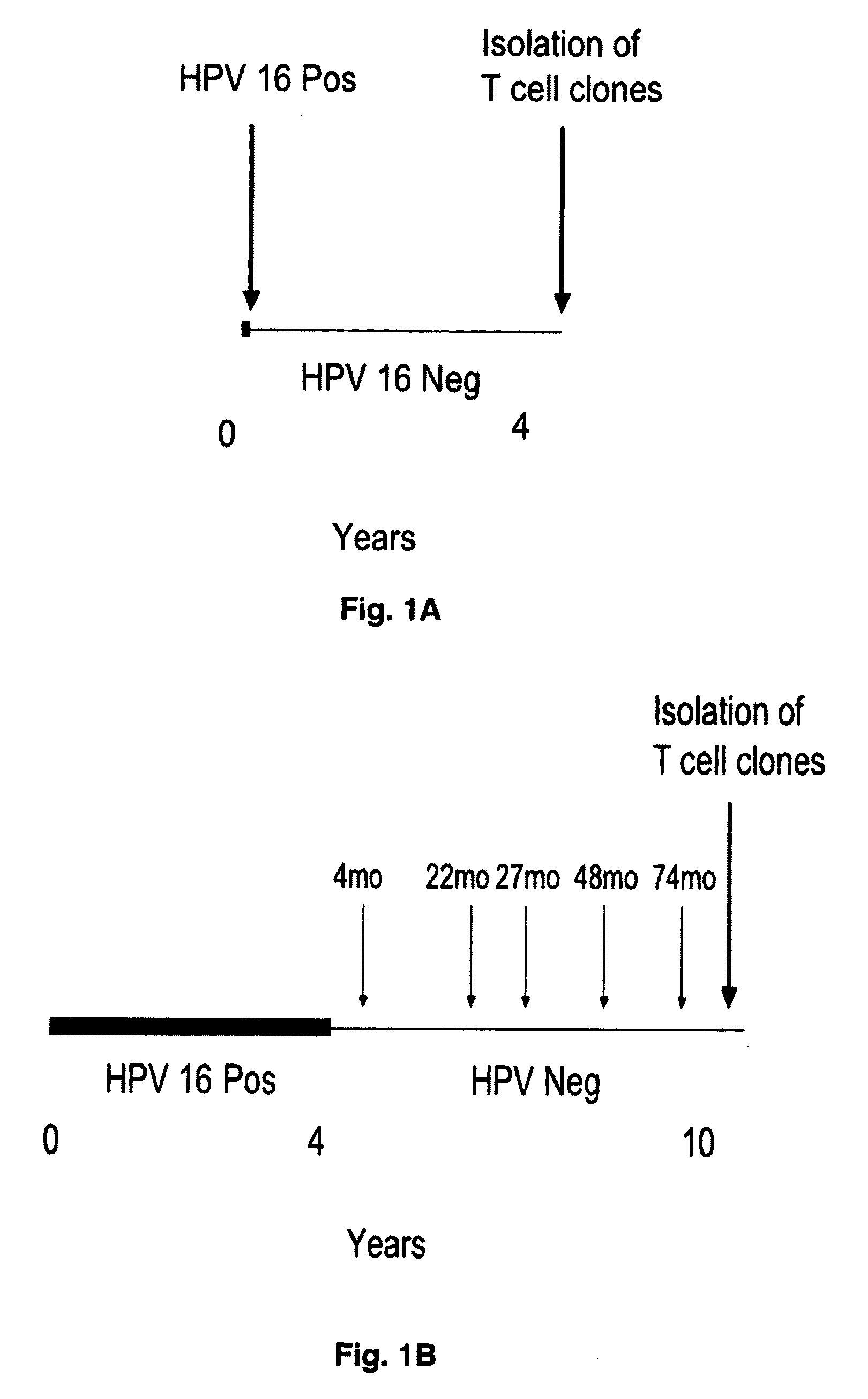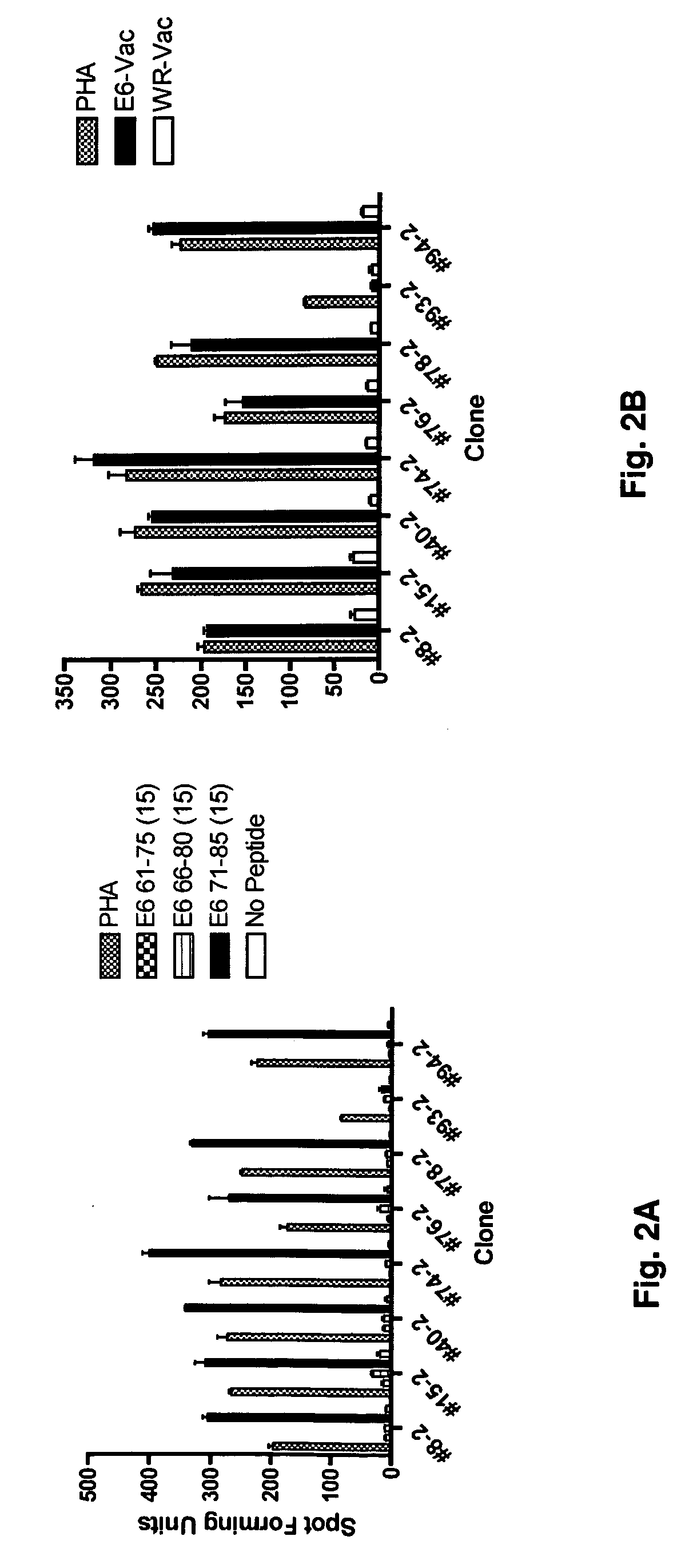HPV E6 protein T cell epitopes and uses thereof
a technology of hpv and e6 protein, applied in the field of immunology, to achieve the effect of increasing the regression of human papilloma virus (hpv)-associated cervical lesions, and preventing or treating a pathophysiological condition in the individual
- Summary
- Abstract
- Description
- Claims
- Application Information
AI Technical Summary
Benefits of technology
Problems solved by technology
Method used
Image
Examples
example 1
Subjects and Cells
[0053]The generation of CD8 T-cell lines from women who were able to clear their Human Papilloma virus infections has been described (Nakagawa et al., 2005). Briefly, the CD8 T-cell lines were established by stimulation peripheral blood mononuclear cells using autologous dendritic cells infected with recombinant vaccinia viruses expressing the HPV 16 E6 protein. Using enzyme-linked immunospot assay, the presence of potential CD8 T-cell epitopes in the E6 31-55 and E6 61-85 regions was demonstrated for subject 2, and that in the E6 31-55, E6 76-100, E6 121-145 regions for subject 18. The blood samples used to establish these CD8 T-cell lines were drawn 53 or 78 months after HPV 16 clearance in subjects 2 or 18 respectively. In this study, these findings were extended by defining the minimal / optimal amino acid sequences and the Human Leukocyte Antigen restriction molecules of the CD8 T-cell epitopes.
example 2
Synthetic HPV Peptides
[0054]A series of 15-mer peptides overlapping each other by 10 amino acids and a series of 9-mer peptides overlapping each other by 8 amino acids covering the HPV 16 E6 protein have been described (37). To define the minimal and optimal amino acids sequences of the CD8 T-cell epitope, 8-mer, 10-mer, 11-mer, and homologous peptides were synthesized as needed (CPC Scientific, Inc, San Jose, Calif.). All peptides were dissolved in small amounts of dimethylsulfoxide (˜50 μl), diluted to 5 mM with phosphate buffered saline, and kept frozen at −80° C. until final dilution for their use in the assay.
example 3
Isolation of Antigen-Specific T-Cell Clones after Magnetic Selection of Interferon-γ Secreting Cells
[0055]The CD8 T cell lines from subjects 2 and 18 were stimulated for two additional 7-day cycles to increase the frequency of targeted antigen specific T-cells as described previously (37). The HPV 16 E6 antigen-specific CD8 T-cell lines (˜2×107 cells from each line) were then stimulated with 10 μM of each peptide contained in positive peptide pools (three 15-mer peptides contained in each peptide pool) for 3-6 h. Following this incubation, the interferon-γ secreting cells were selected using a commercially available kit according to the manufacturers instructions (Interferon-γ Secretion Assay, Miltenyi Biotec).
[0056]To isolate HPV 16 E6 peptide-specific T-cell clones, interferon-γ positive T-cells were plated at a 0.5 cell / well concentration in a 0.5× feeder cell mixture [Yssel's medium containing 1% human serum, penicillin G 100 U / ml, streptomycin 100 μg / ml, 5×105 / ml irradiated all...
PUM
| Property | Measurement | Unit |
|---|---|---|
| concentration | aaaaa | aaaaa |
| concentration | aaaaa | aaaaa |
| concentration | aaaaa | aaaaa |
Abstract
Description
Claims
Application Information
 Login to View More
Login to View More - R&D
- Intellectual Property
- Life Sciences
- Materials
- Tech Scout
- Unparalleled Data Quality
- Higher Quality Content
- 60% Fewer Hallucinations
Browse by: Latest US Patents, China's latest patents, Technical Efficacy Thesaurus, Application Domain, Technology Topic, Popular Technical Reports.
© 2025 PatSnap. All rights reserved.Legal|Privacy policy|Modern Slavery Act Transparency Statement|Sitemap|About US| Contact US: help@patsnap.com



